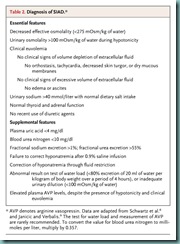Hyponatremia is a common electrolyte abnormality seen in medical in patients. SIADH is the most frequent cause of hyponatremia.
Four types of SIADH is described:

Type A is characterized by unregulated secretion of AVP, type B by elevated basal secretion of AVP despite normal regulation by osmolality, type C by a "reset osmostat," and type D by undetectable AVP. The shaded area represents normal values of plasma AVP.
Clinical features of SIADH are:-
Treatment of this condition involves
The impact of intravenous fluids in patients with syndrome of inappropriate antidiuretic hormone secretion (SIADH) depends on the patient's urine osmolarity. Typically, normal saline's osmolarity of 328 mOsm/L exceeds what is found in a serum sample from a SIADH patient; however, high antidiuretic hormone (ADH) levels raise urine osmolarity in these patients. If the osmolarity level exceeds 328 mOsm/L, the kidneys excrete enough sodium in less than 1 L of urine to equal the amount contained in an entire bag of normal saline. The rest of the "free water" in the normal saline solution is reabsorbed via the ADH, which can decrease the sodium plasma concentration in a SIADH patient. Generally, normal saline should not be used to correct SIADH if the patient's urine osmolarity exceeds 500 mOsm/L.





0 comments:
Post a Comment